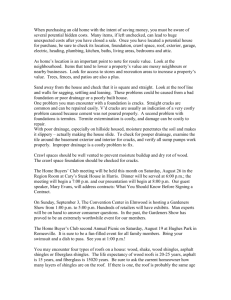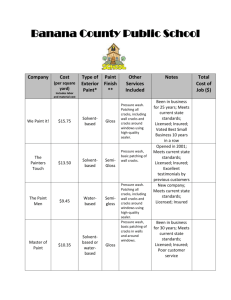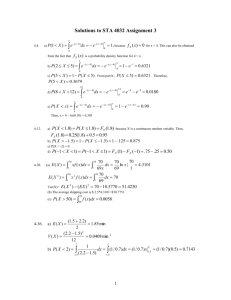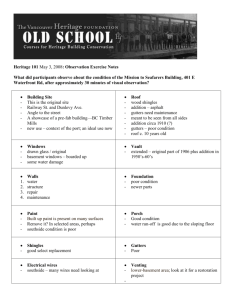Home Inspection Checklist - kauai real estate, kauai hawaii real
advertisement
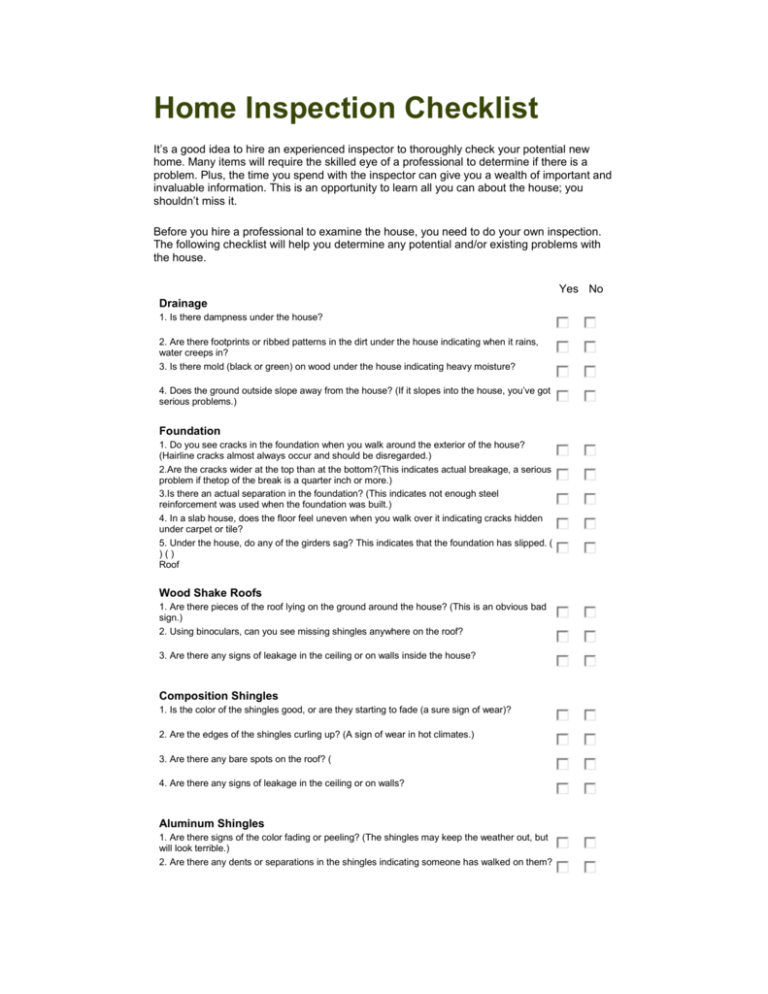
Home Inspection Checklist It’s a good idea to hire an experienced inspector to thoroughly check your potential new home. Many items will require the skilled eye of a professional to determine if there is a problem. Plus, the time you spend with the inspector can give you a wealth of important and invaluable information. This is an opportunity to learn all you can about the house; you shouldn’t miss it. Before you hire a professional to examine the house, you need to do your own inspection. The following checklist will help you determine any potential and/or existing problems with the house. Yes No Drainage 1. Is there dampness under the house? 2. Are there footprints or ribbed patterns in the dirt under the house indicating when it rains, water creeps in? 3. Is there mold (black or green) on wood under the house indicating heavy moisture? 4. Does the ground outside slope away from the house? (If it slopes into the house, you’ve got serious problems.) Foundation 1. Do you see cracks in the foundation when you walk around the exterior of the house? (Hairline cracks almost always occur and should be disregarded.) 2.Are the cracks wider at the top than at the bottom?(This indicates actual breakage, a serious problem if thetop of the break is a quarter inch or more.) 3.Is there an actual separation in the foundation? (This indicates not enough steel reinforcement was used when the foundation was built.) 4. In a slab house, does the floor feel uneven when you walk over it indicating cracks hidden under carpet or tile? 5. Under the house, do any of the girders sag? This indicates that the foundation has slipped. ( )() Roof Wood Shake Roofs 1. Are there pieces of the roof lying on the ground around the house? (This is an obvious bad sign.) 2. Using binoculars, can you see missing shingles anywhere on the roof? 3. Are there any signs of leakage in the ceiling or on walls inside the house? Composition Shingles 1. Is the color of the shingles good, or are they starting to fade (a sure sign of wear)? 2. Are the edges of the shingles curling up? (A sign of wear in hot climates.) 3. Are there any bare spots on the roof? ( 4. Are there any signs of leakage in the ceiling or on walls? Aluminum Shingles 1. Are there signs of the color fading or peeling? (The shingles may keep the weather out, but will look terrible.) 2. Are there any dents or separations in the shingles indicating someone has walked on them? 3. Are there any signs of leakage in the ceiling or on walls inside the house? ( ) ( ) Tiles 1. Are any tiles broken? 2. Have any fallen off? 3. Are there any signs of leakage in the ceilings or on walls? Paint (Interior) 1. Are there marks on the walls? 2. Is the current paint in good condition, or is flaking indicating it will have to be sanded before new paint can be applied? 3. Are the colors light? (Covering dark colors may require two or more new coats.) Paint (Exterior) 1. Is the paint chipping or peeling? 2. Are the colors faded? (This indicates aging paint.) 3. Is the caulking around windows starting to fall out? 4. Is the aluminum siding firm, not becoming detached? 5. Are the gutters falling? Is the paint on them peeling? Plumbing 1. Is the plumbing copper instead of galvanized steel? (Galvanized steel lasts about 30 years, sometimes less – copper lasts virtually forever.) 2. Are there leaks at the joints of galvanized pipes? (These are usually visible under the house or in the garage; they indicate electrolytic action may be corroding the pipes, and they may need to be replaced.) 3. Are there leaks under the sinks in any of the bathrooms or in the kitchen? 4. Is the water heater old? (The date is sometimes stamped on the label – a water heater rarely lasts more than seven years.) 5. Does the water heater have a safety valve? (This is vitally important. If you’re not sure what a safety valve is, have a professional check it out.) Wiring 1. Do switches or sockets spark when used 2. Are there inoperative lights or switches? Heating 1. Does the flame in the furnace turn yellow and rise high above the burners? (A bad sign indicating a ruptured combustion chamber.) 2. Do you smell gas around the furnace? (A very bad sign – call the gas company immediately.) 3. If there is radiant heat or heating that requires plumbing, are there any leaks? Fireplace 1. From the outside, is the fireplace tight against the house, or can you see a separation? (A separation is a big danger sign – have a professional check it out.) 2. Are there any visible cracks in the external bricks? 3. Are there any cracks in the firebricks inside the fireplace? Tile Are there any cracks in the tile of the kitchen or bathrooms? (Cracks can be caused simply by dropping something heavy on the tile or can be symptomatic of the house movements and a cracked foundation.) Termite Report 1. Is there a termite report? 2. Are you getting a termite clearance? 3. Will the seller pay for all repair work? (Normally the buyer pays for any preventive work. Hazards 1. Asbestos ceilings? 2. Asbestos-wrapped pipes? 3. Leaded copper pipe joints? 4. Smoke alarms? 5. Insulation?

![[Agency] recognizes the hazards of lead](http://s3.studylib.net/store/data/007301017_1-adfa0391c2b089b3fd379ee34c4ce940-300x300.png)
